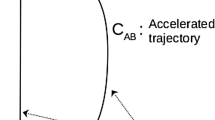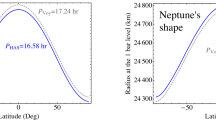Abstract
The large increase in exoplanet discoveries in the last two decades showed a variety of systems whose stability is not clear. In this work, we chose the \(\upsilon \) Andromedae system as the basis of our studies in dynamical stability. This system has a range of possible masses, as a result of detection by radial velocity method, so we adopted a range of masses for the planets c and d and applied the secular theory. We also performed a numerical integration of the 3-body problem for the system over a time span of 30,000 years. The results exposed similarities between the secular perturbation theory and the numerical integration, as well as the limits where the secular theory did not present good results. The analysis of the results provided hints for the maximum values of masses and eccentricities for stable planetary systems similar to \(\upsilon \) Andromedae.










Similar content being viewed by others
References
Barnes R, Grennberg R, Quinn TR, McArthur BE, Benedict GF (2011) Origin and dynamics of the mutually inclined orbits of \(\upsilon \) Andromedae c and d. Astrophys J 726:71
Butler RP, Marcy GW, Hauser EW, Shirts P (1997) Three new “51 Pegasi-type” planets. Astrophys J 474:L115–L118
Chambers JE (1999) A hybrid sympletic integrator that permits close encounters between massive bodies. Mon Not R Astron Soc 304:793–799
Curiel S, Cantó J, Georfie L, Chavez CE, Poveda A (2011) A fourth planet orbiting \(\upsilon \) Andromedae. Astron Astrophys 525:1–5
Gomes RS, Matese JJ, Lissauer JJ (2006) A distant planetary-mass solar companion may have produced distant detached objects. Icarus 184:589–601
Han E, Wang SX, Wright JT, Feng YK, Zhao M, Fakhouri O, Brown JI, Hancock C (2014) Exoplanet orbit database. II. Updates to exoplanets.org the Astronomical Society of Pacific 126:827–837
McArthur BE, Benedict GF, Barnes R, Martioli E, Korzennik S, Nelan E, Butler RP (2010) New observational constraints on the \(\upsilon \) Andromedae system with data from the Hubble space telescope and Hobby–Eberly telescope. Astrophys J 715:1203–1220
Murray CD, Dermott SF (1999) Solar Syst Dyn. Cambrige University Press, Cambridge
Acknowledgements
The authors are grateful for the support from CAPES, Fapesp—proc 2016/24561-0 and CNPq—proc 312813/2013-9. We thank Gabriel Borderes Motta and Alexandros Ziampras for the suggestions. We also would like to acknowledge the hard work made by the referees.
Author information
Authors and Affiliations
Corresponding author
Additional information
Communicated by Eduardo Souza de Cursi.
Rights and permissions
About this article
Cite this article
Camargo, B.C.B., Winter, O.C. & Foryta, D.W. Comparison between Laplace-Lagrange secular theory and numerical simulation: the case of \(\upsilon \) Andromedae planetary system. Comp. Appl. Math. 37 (Suppl 1), 122–132 (2018). https://doi.org/10.1007/s40314-018-0629-z
Received:
Revised:
Accepted:
Published:
Issue Date:
DOI: https://doi.org/10.1007/s40314-018-0629-z




